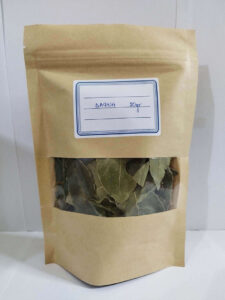Description
The Latin name of the herb is Laurus nobilis L. (Laurus the Noble or Laurel of Apollo). The genus includes only two species. L. nobilis and L. canariesnsis (native of the Canary Islands).
It belongs to the Daphne family.
It is a tree native to Asia, Mediterranean countries and Southern Europe.
It is found in valleys in cool and shady locations. In our country we also find it under the names baya, baya, laura or laurus (from the Latin laurus).
It is a small tree with a smooth bark the colour of ash, with thick, leathery, lanceolate leaves, wavy in the circumference. It has small, greenish-white flowers which grow many together from the axils of the leaves. The fruit is a black rail resembling a small olive.

Historical data
The laurel was known to the Ancient Greeks and Romans. The Romans even called it Laurare (praise) because they believed the tree deserved the highest honors. The Ancient Greeks crowned the victors with the laurel clones of the Apollonius laurel and this custom is still maintained today. It was considered a symbol of wisdom and poetry.
Ingredients
The leaves and fruits are aromatic with a mildly bitter taste. If you chew them you will feel warmth and plenty of saliva. The rails contain 25% fatty oil and up to 3% essential oil consisting of cineole, geraniol and linalool.
They also contain daphne, daphnone, wax, resin, starch, starch, comfrey extract, basorine, albumin and sugar. The leaves are rich in essential oil containing 45% cineole, a bitter substance and tannin.
Therapeutic action
Leaves and fruits (laurel leaves). Tonic and sudorific. Antibacterial, antiseptic, astringent. Diuretic and antispasmodic. It opens the appetite, improves digestion and combats gastrointestinal problems (flatulence, intestinal parasites, etc.). Suitable to treat colds, bronchitis and flu. Daffodil oil and ointment are used for allergy coming from plants, for joint pains and as a parasiticide, even in animals. In addition, the boiled leaves are made into a cold poultice for bruises and sprains. Particular caution in its use is required by pregnant women.
Laurel for insomnia
The decoction of bay leaf, which can be made by boiling 2-3 leaves in a cup of water for ten minutes, is used to fight insomnia and tension. The same decoction is also considered useful in cases of indigestion and anorexia, while bay leaves are believed to have astringent, antidiarrheal, diuretic and diaphoretic properties. It can be drunk up to three cups of tea a day.
Sore throat and abscesses
For sore throats and mouth infections we can also gargle with the above decoction, while the compresses with compresses with water in which we have boiled ten bay leaves may soothe abscesses.
Laurel for great hair
If your hair is falling out or dull, rinse it after shampooing with water in which we have boiled bay leaves and you will be amazed at its shine! To darken the colour in case they have started to turn white, boil 150 g of fresh bay leaves, let the mixture cool and bathe for 15 days.
Laurel in cooking
The leaves of the plant are used as a flavouring in cooking (flavouring foods such as pulses) and in the packaging of nuts such as figs or raisins. The essential oil of the leaves and fruits (laurel oil) is used to make insecticides and pesticides.






Reviews
There are no reviews yet.